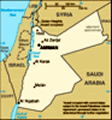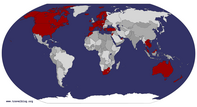Advertisement
Published: November 16th 2007
The Heart of The Holy Land
Sure, if you’re going to go to the Middle East you might as well find yourself a safe corner, right? That’s what we figured when we were planning the end of our trip. Much like our recent (read as too late) infatuation with Africa, we also have a serious infatuation with the Middle East. How can you not have an interest in the cradle of civilization? Sure this area is dangerous, at least more dangerous than some places, but it is also the heart of history. Here you have the founding of three of the world’s top religions, the site of thousands of years of military conflict, and some of the world’s oldest standing structures. What is there not to love?
So, with all that in mind and a healthy dose of caution, we set out to take our first steps into the Middle East. Jordan seemed to be the safest choice that left us options open at a later date. Israel is usually just as safe but once you’ve got an Israeli stamp in your passport you can’t go to any of the other cool countries in the area. Syria,

 The Staff of Moses
The Staff of Moses
Mount Nebo, JordanLebanon, Iran, etc. will no longer allow you to enter their states if they have proof that you have already visited Israel. So, we struck Israel from the list and stuck with its Dead Sea neighbor, Jordan.
First off, let me set your mind at ease about Jordan. While it’s a country that many Americans probably couldn’t locate on a map, it is located directly in the middle of the Middle East. Many people would feel uncomfortable entering a country that borders Saudi Arabia, Iraq, Syria, Israel and the West Bank (I think my grandfather just rolled over in his grave)! But, despite the immediate media induced image you have of the Middle East, Jordan is incredibly safe. With a very large portion of their economy dependent on tourism, Jordan has heavily invested in security. Everywhere you go in Jordan (at least as a tourist) you will see at least ten heavily armed tourist police. These guys’ sole responsibility is protecting you as a foreigner. Sure they may look like they’re just sitting around smoking a cigarette or enjoying a cup of coffee, but any threat would have these machine gun toting, bullet proof vest wearing men running to
defend Jordan’s main source of cash . . . you.
We immediately felt safe in Jordan, maybe even safer than we did when we landed in Dubai, the Las Vegas of the Middle East. In Dubai the airport is a chaotic mess which does little to welcome the entering tourists. While Jordan’s Queen Alia International Airport isn’t as large or as flashy, it is certainly calmer and somehow more respectful. I felt, upon landing that we were off to a pretty good start.
Amman and Roman Ruins
Our first full day in Jordan was spent getting acclimated with Amman’s history. With several old ruins, Amman has at least enough to keep anyone busy for a day. We spent the morning in downtown Amman on a hill overlooking much of the city. Up here there are ruins left by the Romans and a church from the Byzantine era. Certainly not the best ruins I’ve seen in my life, but they were pretty decent.
The better ruins in the city are located at the confluence of some of Amman’s central neighborhoods. Right in the heart of the city is one of the best examples of a Roman
theater that I have ever seen. This huge edifice which is built right into the side of a hill is special because it has been well preserved despite being directly in the middle of a city. Most similar ruins in places like Rome or Athens have to deal with so much pollution that they have not fared anywhere near as well as this monstrosity.
After a decent lunch of fabulous Middle Eastern food, one of our favorite cuisines by far, we set off for the outskirts of Amman to visit Jerash. This Roman garrison town is known as the Pompeii of the Middle East. Having visited Pompeii earlier in this trip I can say that it’s similar but not quite as cool. The ruins are in decent shape but there just isn’t the same feeling of creepiness that makes Pompeii so incredible. Since Pompeii was buried alive under a volcanic ash fall there is a macabre-ness that you just don’t get in Roman towns that just died out with time like Jerash.
One of the cheesy highlights of our time at Jerash was the locally recreated gladiator experience in the hippodrome near the front entrance to the ruins.

 The Tourist Police and Us
The Tourist Police and Us
The omnipresent tourist police really did make us feel safe. This is a picture of our guide and the two of us peering at the touist cops taking a break.Here, in cheesy glory, a team of locals put on mock battles, a mock chariot race and even a demonstration of Roman military formations. While not incredibly informative or well acted it was still a bit of fun. Sure, I may have laughed more than they’d hoped I would, but it was still a good time. I especially enjoyed the chariot races because the Arabian horses are just beautiful. Check out the pictures and tell me what you think.
Later, in the actual ruins of Jerash, Kel decided to wait in one of the town’s ancient open theaters (in the shade) while the guide and I explored out in the sun. While I got to see mosaics, fountains and many columns, Kel was lucky enough to catch a rousing rendition of opera sung by a member of a tour group who just happened to come into the theater while she was waiting. While the opera wasn’t all that enjoyable it was certainly memorable but Jerash itself was a bit of the same stuff we’ve seen in Volubilis, Pompeii and other places. I would say it’s definitely worth your time if you like Roman ruins; if not, don’t waste your
time!
Mount Nebo, Wadi Rum and Madaba Due to the limited amount of time that we had in Jordan, some of our stops ended up being a bit of a whirlwind. Some people allow whole days for the next part of our trip. Instead we managed to do Mount Nebo, Wadi Rum and Madaba all in the same day while on our way towards the ultimate Jordan site, Petra.
Our first stop of the day was Madaba, the location of a stunning section of a mosaic map of the Middle East. This mosaic tiled floor map was created by the Byzantines in the 6th century and then later mosaiced over. Later, in the late 19th century the mosaics were discovered during a renovation of the church it was located in. Only some of the map remained intact through the 13 centuries from its creation to its rediscovery but the pieces that remain are amazing in their detail. This map, which is the oldest map of the Middle East still in existence, is remarkably clear and easy to follow. Similar to so many things you visit in this part of the world, it is amazing to
stare at the mosaiced floor and realize that craftsmen built this site more than a thousand years ago.
From Madaba we headed further south for a quick stop at Mount Nebo. Mount Nebo is a site directly from the bible:
"And Moses went up from the plains of Moab to Mount Nebo, the top of Pisgah, which is opposite Jericho." (Deuteronomy 34:1).
From the top of the decent sized hill, one can see the Holy Land, the Dead Sea, the Jordan River and (on a good day) Jerusalem. We spent about an hour on the hill touring the ruins that were discovered here in the 1930’s. The church and monastery that sit on top of the highest point of this hill are dated from the 4th Century AD and once again have some pretty serious mosaics which managed to last through the iconoclastic period (when mosaics and other art which depicted people were destroyed as unreligious) because they were floored over with another layer of mosaic.
The items on Mount Nebo that really make it worth the visit are the view and the giant cross which stand above the Holy Land. The cross depicts the
serpent which Moses used to cure those that had been bitten by snakes mentioned in Numbers 21:4-9. The huge brass replica has immense power because of its form and its location. Kel and I both found the view with the cross to be amazing.
The final stop for the day was Wadi Rum. This desert park could take people days to explore, we did it in an hour and a half. We were pretty sad that we didn’t have more time to get Wadi Rum in but it barely fit into our schedule as it was. We did get a chance to see a glorious sunset and some of the amazingly old cave drawings. The graffiti left in Wadi Rum by the Nabataeans date from the first century. Like the mosaics in Madaba and Mount Nebo, the writing in the caverns of Wadi Rum is amazing because of its age.
After a full day of traveling and seeing sites, Kel and I completely crashed at our hotel in Petra. By time we arrived, a few hours after dark, we would have slept on a cold marble slab if we’d have had to. But, as often happens after an
incredibly busy day, we felt incredibly proud to have accomplished so much and felt that sleep was much deserved.
Hope you’re all well at home! We miss you! Keep reading!
Advertisement
Tot: 0.092s; Tpl: 0.018s; cc: 12; qc: 24; dbt: 0.052s; 1; m:domysql w:travelblog (10.17.0.13); sld: 1;
; mem: 1.1mb




























capsfan2002
capsfan
Blog
I so enjoy your blogs. You go to the most incredible places. I hope to do the same some day!